Back pain is a very common condition experienced by 80 % of people at some point in their lives. Muscle strain or pulled muscle is one of the leading causes of back pain, which can be healed entirely through proper rest. Muscle strain usually occurs when your muscle is overstretched or torn.
Even though it is a common cause for back pain, several structural problems like ruptured disks, bulging disks, sciatica, arthritis, kidney problems, osteoporosis, abnormal spinal curvatures, etc., may also result in back pain. In these cases, bed rest has only a limited role in healing back pain. However, gentle stretching and easy exercises can help relieve sore backs.
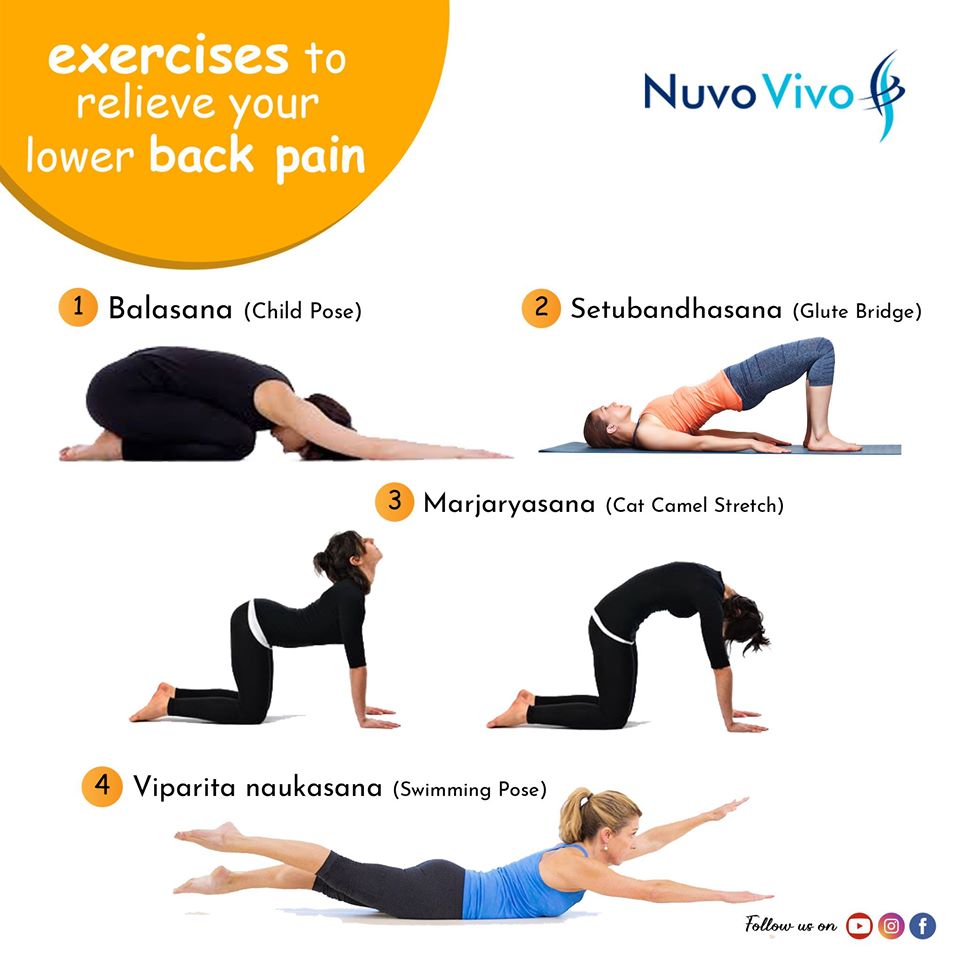
As you perhaps know already, our spinal cord is an intricate bundle of nerves and tissue that extends from the brain’s base through the entire length of our back. It is protected by the bones (or vertebrae) that make up the spine. The spinal cord is responsible for communicating messages to and from the brain to all parts of the body – your muscles, organs, etc.
The spinal cord can be broadly divided into 4 sections –
- Cervical region
- Thoracic Region
- Lumbar Region
- Sacral Region
As you notice in the below picture, each of these regions has a series of discs of connecting bones of almost similar structure.
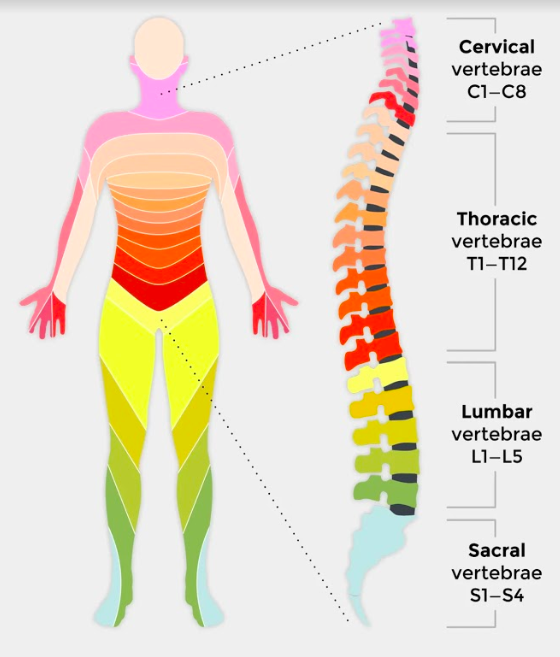
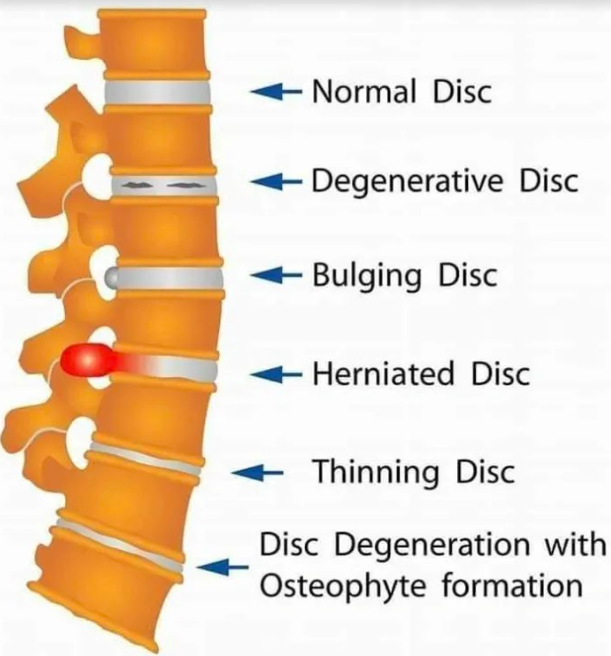
Lower Back Pain: How Does Exercise Helps to Reduce Pain?
Lower back pain is a painful condition affecting the lumbar region of the spine. The lumbar region, commonly known as the lower back, is situated between the thoracic and sacral vertebral segments. It is made up of five distinct vertebrae numbered L1-L5.
Lower back pain is often associated with the lumbar spine, intervertebral discs, ligaments around the spine and discs, spinal cord and nerves, lower back muscles, internal organs of the pelvis and abdomen, and the skin around the lumbar area.
Engaging in exercises, yoga, or any fitness activities helps strengthen the back and abdominal muscles, thereby alleviating and preventing back pain. It also aids in relieving stiffness by increasing the flexibility of connective tissues of ligaments and tendons.
In this article, you can find various step-by-step instructions on exercises to relieve back pain. Firstly let’s find out the potential benefits of exercises in reducing lower back pain as well as upper back pain. The advantages of exercises are:
- Exercises help strengthen the muscles that support your spine and ease pressure from the facet joints and spinal discs.
- It aids in relieving stiffness and enhancing mobility.
- It improves blood circulation, ensuring a better supply of nutrients throughout the body, including spinal discs.
- The body releases chemicals called endorphins when you perform exercises. Endorphins diminish the perception of pain as they act on the opioid receptors in your brains.
- The gentle poses and breathing techniques in yoga exercises can do good for your spine.
10 Exercises to Relieve Your Back Pain
Given below are a few exercises that can relieve you from lower back pain. Here, we try to improve the strength of muscles around your lower back such that the strain on your spinal cord and disc is minimal. This will provide great relief, improve your posture, reduce your pain, and keep your spine healthy.
1. Child’s Pose (Balasana)

Child’s pose is an excellent resting posture in yoga that helps to gently stretch the muscles of the back, hips, thighs, and ankles. This is a profoundly relaxing and effective exercise to relieve lower back pain. It is also a great restorative exercise to relieve back pain during pregnancy.
- Kneel on your hands and knees.
- Keep your toes on the floor and knees about hip-width apart.
- As you exhale, slowly lower your buttocks towards your heels, feeling the tailbone lengthen away from the back of your pelvis.
- As your torso folds over your thighs, lengthen the back of your neck before your forehead rests on the floor.
- Stretch your arms forward, about shoulder-width apart, with your head resting on the floor. Your neck should be relaxed, and your buttocks, resting on your heels.
- Keep your gaze drawn inward with your eyes closed. Hold for up to a minute or longer, breathing softly.
2. Cat Camel Stretch (Marjarasana)
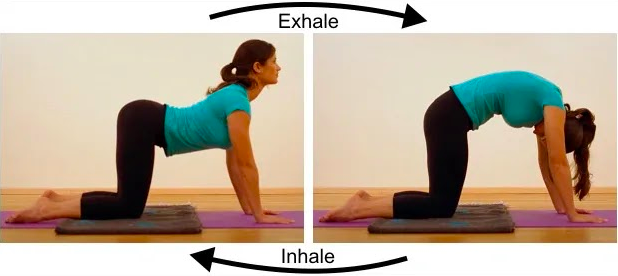
Cat Camel Stretch is a soothing exercise that helps with the pain of the low or mid-back. This yoga exercise for back pain brings flexibility to the spine and stretches and strengthens core muscles.
- Starting Position – Kneel on your hands & knees. Place your hands, shoulder-width apart, and your knees, hip-width apart on the floor.
- Bring your back into a horizontal in a “neutral” and flat starting position.
- Downward (Cat) Phase: Gently inhale, and using the abdominal and low back muscles, tip your tail toward the ceiling while increasing the arch in your mid and low back. Allow the abdomen to stretch toward the floor. Pull your shoulder blades down your back (like a cat stretching). Hold this position for 3-5 seconds before returning to your starting position.
- Upward (Camel) Phase: Gently exhale and tuck your tailbone under and use your abdominal muscles to push your spine upwards towards the ceiling, making the shape of a camel’s hump. Hold this position for 3-5 seconds. Lengthen your neck and allow your head to reach toward your chest, maintaining alignment with the spine.
- Continue to cycle between the Cat and Camel phase several times. Feel the movement of each vertebra and welcome the growing mobility of the spine with each cycle.
- Listen to your neck and spine and never feel yourself overextending and creating pressure in your spine.
- After about 3-5 cycles of each phase, sit into Child’s Pose for 15 seconds before returning to your Cat Camel articulations.
3. Glute Bridge
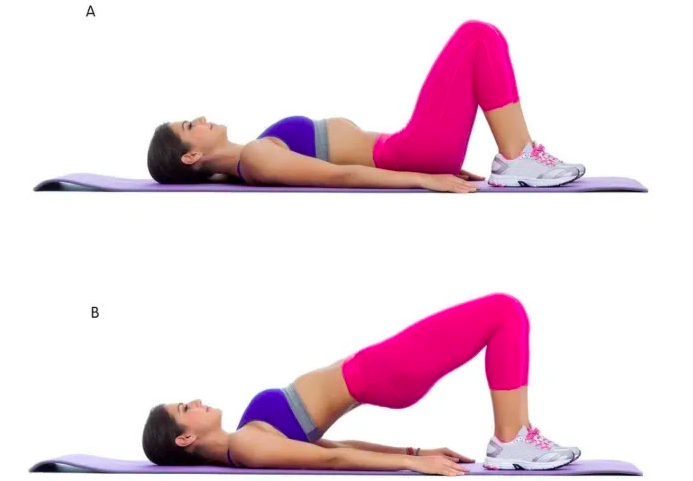
The glute bridge exercise strengthens the glutes, hamstrings, lower back, and abdominal muscles. It is very effective to build the resilience of the lower back and ensure lower back pain relief. It is also one of the most beneficial exercises during pregnancy, which aids in relieving backaches.
- Lie on your back with your knees bent and your feet flat on the floor. Hold your arms at your side with your palms down.
- Tighten your glutes and lift your hips off the floor.
- At the highest position, there should be a straight line from your knees to your shoulders. Hold the contraction for five seconds before returning to the starting position.
4. Back Extension
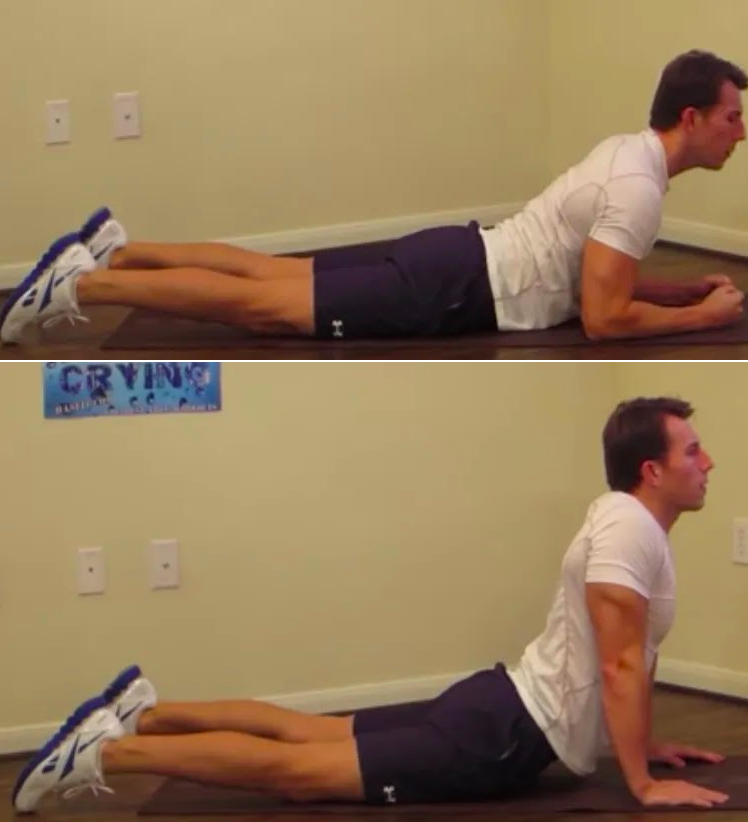
Back extension exercises are also referred to as hyperextensions, a type of stabilization exercise that works the lower, mid, and upper back. It creates a dynamic stretch in your back and strengthens the lower back muscles. If you have lower back pain, this exercise can provide some relief.
Level – 1 ( Easier Version)
Level 2 (Moderately Tougher Version)
- Lie down on your stomach. Keep your arms close to your body. You can bend your elbows as well.
- Keep your legs apart, as shown below
- Make your abs tight and lift your stomach off the mat. Support with your elbows on the floor (level 1) and raise your chin.
- If this feels comfortable, move to level 2, i.e., support both palms on the floor, raise your chin and extend and stretch your back. Your spine will lengthen, and energy shall spread from your head. It’s important to keep your back lowered.
- Hold this position for 3 – 5 seconds. This movement should be repeated around 5 – 7 times. It’s crucial to relax throughout.
5. Swimming Pose

Swimming is a back extension exercise, a great form of exercise that strengthens the muscles of the back and improves your posture, balance, and mobility.
- Lie down on your stomach, keep your legs together without bending.
- Do not bring your shoulders near your ears. Keep the shoulder blades in your back. Your arms should be over your head now. Stretch for a few seconds.
- Make sure your abs are tight. Bring your navel above the ground.
- Breathe in and stretch out your left arm, right leg, and spine as far as possible, as shown below. Make sure your face is down. Hold for 3 – 5 seconds.
- Now, alternate your hands and legs. Breathe in and hold for 3 – 5 seconds. This should feel like swimming in a pool. Keep an even rhythm of swimming by switching hands and legs.
6. Knee to Side Stretch
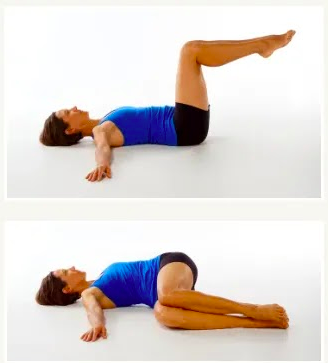
Knee-to-side stretch can help relieve tension in the lower back and torso. It also works your core muscles and helps stabilise the low back and pelvis.
- Lie flat on your back, bend the knees, and lift the feet off the floor. The calves should be parallel to the ground. Flex your feet and extend the arms out to the sides like a “T.”
- Press the palms into the ground. Take a deep breath, feeling your back body expand into the earth. On the exhalation, guide the knees/legs to the left side, coming into a twist. Stay in this position for around 3 seconds.
- If you are not flexible enough and unable to bring your leg to the floor, then you can stop at 45 degrees (i.e. halfway through) and do the same in both directions.
- Do this for both the right and left sides.
7. Supine Spinal Twist (Supta Matsyendrasana)
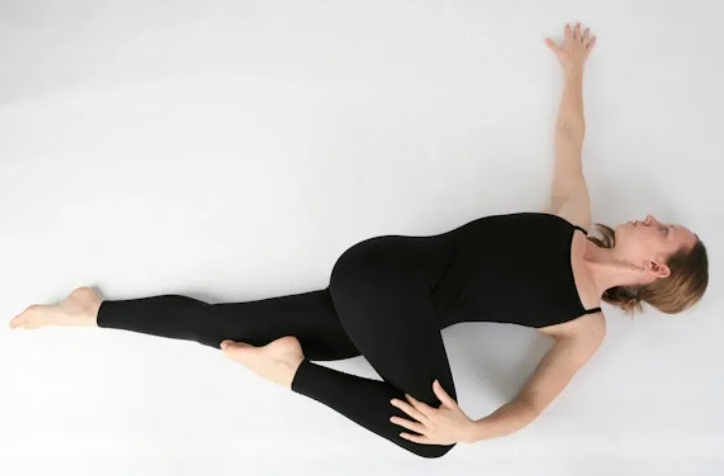
Supine spinal twist is another great exercise that improves spinal mobility and relieves back pain. This gentle posture stretches your back muscles, hips, and glutes.
- Lie down on your back in the supine position with one knee bent and cross it outside the opposite foot.
- Use the hand to put slight pressure on the bent knee to push down towards the floor.
- Keep both shoulders squared and rooted to the floor.
- Extend the opposite hand and gaze towards the hand.
- Hold this position for 7 – 10 seconds.
- Get back to a neutral position and continue with the other knee–hand combination.
8. Knee to Chest Stretches
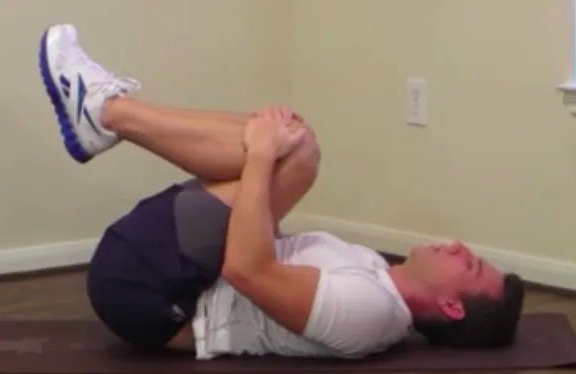
The knee-to-chest stretch is a relaxing way to restore flexibility in your low back muscles. It is one of the most beneficial stretches for low back pain.
- Lie down on your back comfortably.
- Hold around the knees with your palms bringing knees as close as you can to your chest.
- DO NOT roll up and lift your head/neck upwards or towards the knee. Your head should always rest on the floor. Similarly, DO NOT raise your lower hips from the ground and roll your lower body up. Your hip should rest on the floor.
- If you are unable to bring the knees closer to the chest, do not exert yourself too much. It will gradually improve.
- Hold this position for 10 – 15 seconds.
9. Single Knee to Chest Stretch
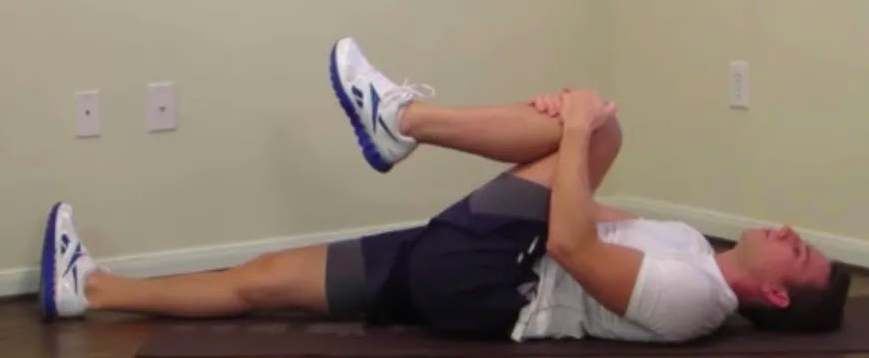
Single knee to chest stretch is an exercise used to stretch your lower back (lumbar spine), hamstrings and glutes muscles. This exercise eases back pain by relieving the pressure on spinal nerves.
- Lie down on your back comfortably
- Hold your left knee with your palms bringing the knee as close as possible to your chest.
- DO NOT roll up and lift your head/neck upwards or towards the knee. Your head should always rest on the floor. Similarly, DO NOT raise your lower hips from the ground and roll your lower body up. Your hip should rest on the floor.
- Hold this position for 10 – 15 seconds
- Bring your knee and legs to the original position and then repeat with right knee and hold for 10 – 15 seconds
- If you are initially unable to bring the knees closer to the chest, do not worry or exert too much. It will improve gradually.
10. Raised Leg Stretch

Straight leg raise stretch exercise is often used in physiotherapy to restore the strength of your lower back, which can be very helpful in relieving pain.
- Lie down on your back with palms facing downwards on the floor, head & neck straight, and on the floor.
- Gently raise the right leg, without bending, up to 90 degrees/perpendicular to the ground.
- Make sure the left leg does not raise and is touching the floor.
- Hold this position for 5 – 7 seconds. Keep your breath slow and steady.
- Gently release the right leg and alternate with the left leg.
Ways to Relieve Your Lower Back Pain Naturally
How can I relieve my lower back pain? This is a common question asked by many people. We have already discussed the benefits of exercise, how to get relief from back pain with exercise and what are the different types of exercises that can be done for back pain. In addition to exercising to avoid back pain, there are some other things to look out for. In the section below, let’s discuss the ways to keep back pain away.
- Keep good posture while sitting to ease the pressure on your lower back. Sit upright with your body supported against the back of your chair. Don’t slouch or stoop; always keep the alignment of the spine.
- Regular application of ice to the painful areas of your back may help lessen inflammation in acute phases of back pain.
- A heating pad or warm pack may help relax stiff or tight muscles and improve blood flow to the affected area.
- Avoid excessive sitting as it puts too much pressure on your spinal discs.
- Maintain a healthy weight because carrying extra weight can significantly strain your back muscles and spine.
Neck and Shoulder Stretches
Stretching is a gentle way to relieve upper back pain, neck pain, shoulder pain and much more. Let’s discuss some basic stretches to loosen tension in both your shoulders and neck.
1. Flexion Stretch – Chin to Chest
Gently bend your head forward as you bring your chin toward your chest. Stop and hold the position for 15-30 seconds when you feel a stretch in the back of your neck. Repeat this stretch five more times after returning the neck to the midline position.
2. Lateral Flexion – Ear to Shoulder
Slowly bend the neck to bring your right ear to your right shoulder until a stretch is felt in the side of the neck. During this stretch, ensure you maintain body alignment keeping your shoulders down and back. Hold the position for 20 seconds before returning the head to the neutral position. Do 2–4 repetitions on both sides.
3. Levator Scapula Stretch
Raise one arm with the elbow slightly above the shoulder and rest it on a wall, then turn the head to face the opposite direction. Tilt the chin down toward the collarbone to feel a stretch in the back of the neck. It may be helpful to softly pull the head forward with the other hand to hold the stretch for 30 to 60 seconds. Repeat on the other side.
4. Corner Stretch
Stand about two feet back from the corner with feet positioned together, facing the corner of the room. Place the forearms on adjacent walls with the elbows slightly below shoulder height. Then lean forward until a good stretch is felt across the chest and shoulders and hold the position for about 30 seconds to a minute.
General Tips for Stretching to Alleviate Back Pain
Even though people do stretching to relieve pain and tension along their spine, neck, and shoulders, using improper stretching techniques can have the opposite effect. To avoid the risk of injury, keep the following suggestions in mind while stretching.
- You should wear comfortable clothes that won’t restrict your movement.
- Never stretch beyond your point of comfort. It is normal to feel some tension while stretching, but if you experience pain, it means you injured or overstretched a muscle. If you hurt the area you are stretching, stop stretching immediately.
- Avoid bouncing or any other movements while stretching as it can cause significant strain on your muscles.
- Although stretching is usually advantageous, overdoing it will do more harm than good. Stretching multiple times the same muscle groups can cause damage. Make sure you don’t exhaust your body.
- If you are suffering from a muscle injury, stretching may not be safe. Overstretching an already injured muscle can cause extra damage. Therefore, only do stretches recommended by your doctor.
- For stretching, choose a clean, smooth, flat surface with ample space to move freely.
- Hold each stretch 15-30 seconds to lengthen the muscle and enhance the range of motion sufficiently.
This article discussed several aspects of stretching and exercises for back pain relief, including how to reduce back pain by exercise, the benefits of exercises, ten efficient exercises to relieve back pain, neck and shoulder stretches, and tips for stretching to alleviate back pain. By practising these simple exercises for back pain may help prevent the recurrence of lower backache.
However, when you have back pain, it is imperative that you first consult your orthopedist to understand the nature of the pain. We notice that people often try to treat themselves for back pain. We don’t recommend this. DO NOT attempt the exercises mentioned above unless you have already consulted your doctor or physiotherapist.
Programs @ NuvoVivo
NuvoVivo Centre for Obesity, Lifestyle disorders & Research is an online health & fitness company, and we help our clients anywhere in the world become healthy through our 3-month diet & exercise programs!
We help them lose body fat, pack some muscles and manage lifestyle disorders such as –
- Diabetes
- Cholesterol
- Thyroid
- PCOD
- Fatty Liver
- Uric Acid
- Hyper Tension
- Obesity / Weight Management
Our program details @ https://apple.co/2ZNJzNi

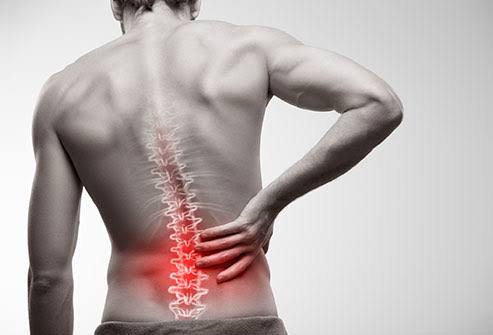
This Post Has 23 Comments
Very helpful post. The pics of exercises are self-explanatory. Thank you for adding the great notes about how one gets back pain and how to get rid of back pain.
Glad you find it helpful Stella 🙂 Thank you
Great. Thank you for this wonderful post. I will definitely try these exercises to cure my back pain. The cat camel stretch is really good. I do two rounds of Surya namaskar every day in the morning and it is really energetic.
Aah! keep us posted! 🙂
Best exercises to do while having back pain. Thanks for sharing the article.
You are welcome! 🙂
It’s interesting to know that some exercises like the balasana child pose will help you to prevent back pain. My husband has been struggling with back pain, and we are looking for advice. I will let him know about your recommendations to choose the right exercise to help him.
sure! keep us posted! 🙂
Thanks for the awesome exercise for back pain. Those people who work in the office with low back pain, should they change their chair or take often break in working? What you suggest >
You are welcome Judy! They should definitely use a chair that is more ergonomically friendly., taking occasional breaks too will help
Pls mention something about how many sets and how many repetitions should be done
You may do this up to 5-10 reps. the deal is to do them such that it is not too much bothering your back.. yet giving relief to the pain
Over this article we come to know about the managing chronic pain 6 alternative treatment are explained in detail. This is such a wonderful article. So, anyone searching for same topic may find their shelter over here. Thanks for this wonderful content.
I’ve been experiencing extreme pain in my back due to work out, which is why I’m currently looking for a service that offers a pain management service. It’s a great thing that you shared here the different types of exercises that will be able to help relieve lower back pain. I also never that these exercises may improve the muscles and posture.
Great blog for back pain. I actually learnt alot for back pain.
Exercises are essential for your back pain. But if your are a office worker. I will highly recommend you to get some best office chairs for back pain. Thanks a lot for this guide.
Thanks for approving
You are welcome David
Nice explanation, I got all your points. Keep suggesting such helpful content.
Hello, thank you for sharing this article it will be really helpful for me to understand about exercises to relieve your back pain. I appreciate your step for choosing this topic. Great article!! You have done a good research I must say, thank you very much for sharing this article.
My cousin has been having a lot of back pain because he has been working from home. Getting some treatment from a professional could help him to be more productive. Thanks for explaining how there can be some disc-related issues if it isn’t attended to properly.
The exercises that you menetioned are simple and easy to perform for back pain. Thank you for sharing multiple exercises in one image. Main reason to perform exercises are to Improve flexibility, strength and reduce stiffness.
Navigating the intricate labyrinths of the spine’s regions and connections, this discourse on lower back pain gracefully introduces a symphony of stretches and exercises. As the lumbar region bears the silent weight of our daily endeavors, it cries out for moments of reprieve. And what better solace than the harmonious alignment in the Cat Camel Stretch or the deep rest of Balasana? Here, pain relief is not just a mere physical act but a dance between awareness and intent, where each pose is a whisper to the weary vertebrae, a promise of strength and solace.